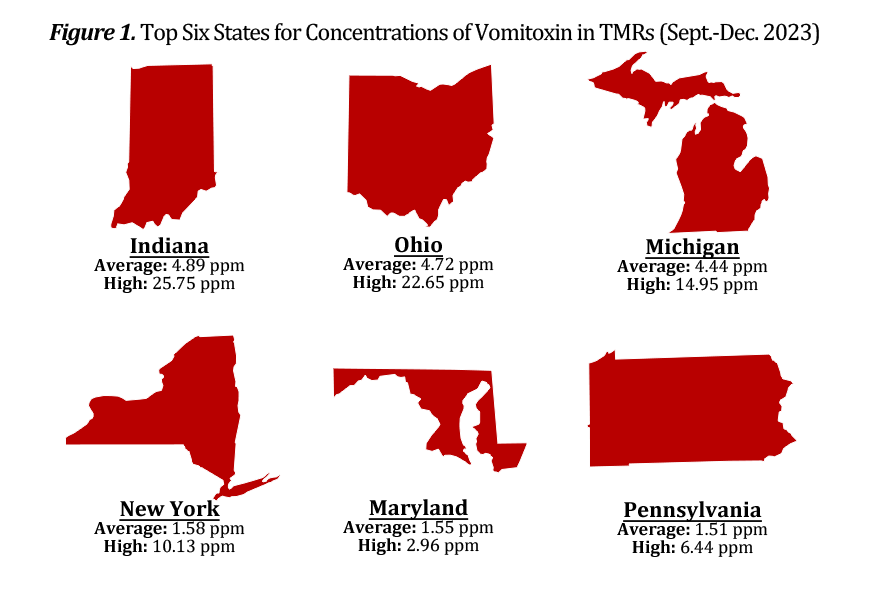
By Dr. James C. Coomer, Ph.D., PAS
Mycotoxins seem to be discussed everywhere in livestock nutrition press these days and it appears mycotoxins are an inevitable part of nutrition now and into the foreseeable future. DSM recently released their December mycotoxin survey, including their corn mycotoxin survey results for 2023. The survey of 123 corn samples from 15 states found 94% of the samples were positive for at least one mycotoxin. Meanwhile, 72% of samples were positive for more than one mycotoxin of the six major mycotoxin groups tested.
The percentage of samples positive by group was higher in three of the major mycotoxin groups in 2023 than in 2022. Zearalenone had the highest positive sample increase, from 31% in 2022 to 68% in 2023. In a recent issue of Michigan Farm News, Robert Geers, vice president of merchandising for Michigan Agricultural Commodities, indicates they are seeing some of the highest concentrations of mycotoxins they have ever seen in the state.
In early 2023, Agri-King started conducting mycotoxin analysis by LC-MS/MS (liquid chromatography-tandem mass spectrometry) and now tests each sample for four major mycotoxins (aflatoxins, vomitoxin, zearalenone, T-2/HT-2). Mycotoxin concentrations can now be tested on a wider variety of samples using this new technology, and Agri-King has focused on testing TMR samples. In the last four months of 2023, Agri-King has tested mycotoxins on 591 TMR samples from the United States and 68 TMRs from the UK and Ireland. Additionally, Agri-King has analyzed 194 corn silage samples.
The international TMR samples did not indicate any serious concerns with the four mycotoxins tested, with only one sample having a very high level of zearalenone and no other samples having a high or very high concentration of concern with these four mycotoxins. However, reports from the UK and Ireland, with the use of Agri-King’s AKMC product, indicate that there may be issues with other mycotoxins that have not been tested for, as field reports of 1-3 liter (2.2-6.5 lb) increases in milk production when feeding AKMC and subsequent loss of that amount of milk production upon removal of AKMC from the diet. Therefore, additional research is needed to determine what mycotoxins may be causing issues with dairy production in the UK and Ireland.
Results from the U.S./North America TMR samples indicate that T-2/HT-2 are of very little concern with zero samples having high or very high-risk concentrations (>300 parts per billion [ppb]). Also, aflatoxin results indicate very little problem with only six samples having high or very high concentrations of aflatoxin (>20 ppb) and all those samples were from the southern half of the continent: Georgia (4), North Carolina (1) and Mexico (1). Even though the overall risk of aflatoxin is very low across the U.S. and North America, the risk to individual farms may be great and may cause issues with a farm’s ability to ship milk due to the FDA regulations on aflatoxin concentration in milk.
The greater concern appears when results for vomitoxin and zearalenone are considered. The average vomitoxin concentration of the 591 TMR samples tested from 21 U.S. states was 2.0 ppm, indicating a moderate to high risk. The highest vomitoxin concentration tested was 25.75 parts per million (ppm), which is very high risk. The top six states for vomitoxin are listed in Figure 1 along with their average and high vomitoxin concentration. Three of the five states had average vomitoxin concentrations that would be considered very high risk (>4 ppm), and the other three states had concentrations that would be considered high risk. Additionally, five of the top six states are in the Great Lakes region of the country and Indiana and Ohio are major suppliers of corn and corn co-products for the U.S.

The zearalenone results look very similar to those of vomitoxin results with an average concentration of 215 ppb indicating a moderate risk. The highest zearalenone concentration tested was 3,414 ppb, which indicates a very high risk (>600 ppb). The top five states for zearalenone concentrations are listed in Figure 2. Two of these states have average concentrations that would be considered very high risk (>600 ppb), one has an average concentration that would be considered high risk (250-400 ppb), and the other two states have concentrations that would be considered moderate risk (100-250 ppb). All five of these top states are in the Great Lakes region, with Pennsylvania replacing Maryland in the top five. With these concentrations of zearalenone in TMR samples, it should be expected that reproductive issues will arise if efforts are not taken to alleviate these negative effects.

As these results indicate, adverse effects of vomitoxin and zearalenone could be showing up in the Great Lakes region of the U.S. Concentrations of these two mycotoxins could continue to increase in TMR samples as more farms start to use 2023 corn silage — many farms this fall were still using 2022 corn silage. Positive production and reproductive results have been reported from field observations when Agri-King’s AKMC has been fed in diets with challenging feedstuffs. AK